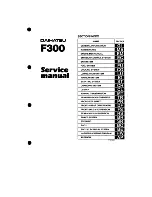
Fig. 156
In the load compartment: fastening
rings.
There are fastening rings
→
luggage compartment which can be used
to secure loose items and luggage with the
help of lashing, retaining or securing straps
→
.
Securing the load on the fastening rails
1. Fold up the fastening rings
→
2. Position the lashing, retaining or secur-
ing straps over the load
across both di-
agonals
and hook them into the fasten-
ing rings.
3. Pull the lashing, retaining or securing
straps tightly over the load. Make sure
that the cross-over of the lashing, re-
taining or securing straps is positioned
in the centre of the load.
4. Check whether the load can still be
moved. If necessary, tighten the secur-
ing straps even more tautly.
WARNING
Unsuitable or damaged lashing, retaining
or securing straps could tear in the event
of a braking manoeuvre or accident. This
could cause objects to be
flung
through
the interior and lead to severe or fatal in-
juries.
·
Always use suitable and undamaged
lashing, retaining or securing straps.
·
Attach lashing, retaining or securing
straps securely to the fastening rings.
·
Load the fastening rings evenly.
·
Never
fix
lashing, retaining or securing
straps between the fastening rings in
the side panel and the fastening rings in
the vehicle
floor.
·
Never
fix
lashing, retaining or securing
straps between opposite side walls.
·
Never load the lashing, retaining or se-
curing straps beyond their load rating.
·
Attach lashing, retaining or securing
straps securely to the fastening rings.
·
Loose objects in the load compartment
can suddenly slide and change the way
the vehicle handles.
·
Small and light objects should also be
secured.
·
Never secure a child seat using the fas-
tening rings.
·
Ensure that the load retains its form
and position once it has been secured.
Use sturdy packaging and anti-slip un-
derlay for your load.
·
Pull lashing, retaining and securing
straps taut crosswise over the load on
the luggage compartment
floor
and at-
tach them securely to the fastening
rings.
·
Make sure that the upper edge of the
load is higher than the fastening rings,
particularly when stowing
flat
objects.
Maximum load capacity of the
fastening rings
Fastening rings Permissible nominal
tensile load
Tourneo Connect 300 daN
1 daN (decanewton) corresponds to
10 newtons.
Varying
country-specific
requirements are
met.
NOTICE
Observe the details on the maximum load
capacity of the individual fastening points.
In the event of full braking, forces act that
can be many times higher than the weight
of the load being transported. Always use
multiple fastening points in order to distrib-
ute absorption of these forces and to en-
sure equal stress on each fastening point.
Load compartment equipment
267
2KF012
720AB
Summary of Contents for TOURNEO CONNECT
Page 13: ...Driver door 11 2KF012720AB ...
















































